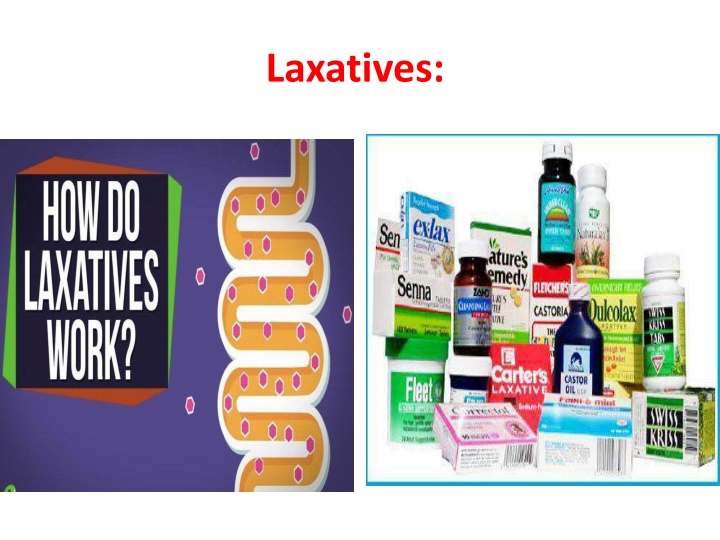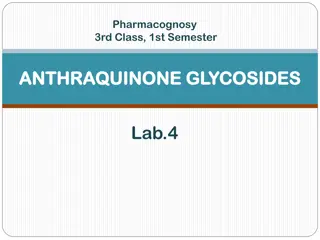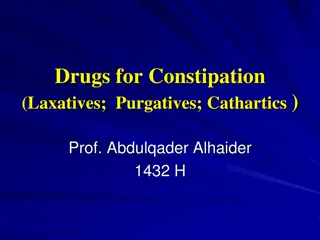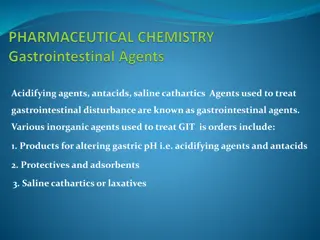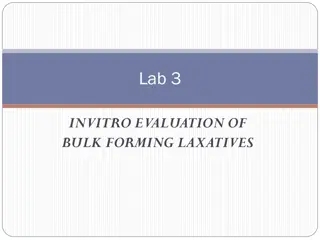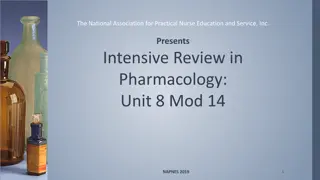Laxatives
Laxatives are drugs used to promote defecation by reducing viscosity or stimulating colonic contraction. They are classified as bulk laxatives, osmotic laxatives, faecal softeners, and stimulant laxatives. Bulk laxatives like bran and methylcellulose increase volume for bowel activity. Osmotic laxatives such as magnesium salts and lactulose hold water for osmotic effect. Faecal softeners like docusate sodium soften faecal material. Stimulant laxatives like bisacodyl, senna, and castor oil increase motility but should be used cautiously. Lactulose, a synthetic disaccharide, acts as an osmotic laxative and has additional hepatic encephalopathy benefits. These various laxatives serve different purposes and should be used appropriately based on individual needs.
Download Presentation

Please find below an Image/Link to download the presentation.
The content on the website is provided AS IS for your information and personal use only. It may not be sold, licensed, or shared on other websites without obtaining consent from the author.If you encounter any issues during the download, it is possible that the publisher has removed the file from their server.
You are allowed to download the files provided on this website for personal or commercial use, subject to the condition that they are used lawfully. All files are the property of their respective owners.
The content on the website is provided AS IS for your information and personal use only. It may not be sold, licensed, or shared on other websites without obtaining consent from the author.
E N D
Presentation Transcript
Laxatives: Laxatives are the drugs used to promote or help defecation by reducing the viscosity of the contents or stimulate colonic contraction and are classified according to mechanism of action as: 1. Bulk laxatives 2. Osmotic laxatives 3. Faecal softeners 4. Stimulant laxatives
1. Bulk Laxatives Bran and methylcellulose Acts by increasing the volume and reducing the viscosity of the contents which lead to effective reflex bowel activity. Bran is the residue of the flour. It contains fibers which are not digestible so enter into the colon intact. It has great capacity for holding water increasing the volume and reducing the viscosity of the colonic contents.
2.Osmotic laxatives Magnesium salts & Lactulose They increase the bulk and reduce the viscosity by holding water by osmotic effect Magnesium salts: Magnesium hydroxide Acts by retaining water in the contents and can also withdraw water from the body to the intestine. Its effect in 2-4 hours.
Lactulose: Is a synthetic disaccharide it can be taken orally as it s not metabolized and acts as osmotic laxative. It is also used in hepatic encephalopathy as it splits into lactic and acetic acids which inhibit the growth of ammonia producing organisms and also by lowering intestinal PH can reduce diffusion of ammonia into the colon. Osmotic laxatives can be used to clear the colon in diagnostic procedures as colonoscopy or radiology or in preparation for colonic surgery. They can be given orally or as retention enema
3. Faecal softeners Docusate sodium Lead to softening of the faecal material which is useful in conditions like haemorrhoids and anal fissure. Docusate causes softening of the faeces by lowering the surface tension of fluids in the bowel, this allows more water to remain in the faeces. It takes 1-2 days to act. So used prophylactically. It is safe in pregnancy.
4. Stimulant laxatives Bisacodyl, Senna and castor oil These drugs increase the intestinal motility by various mechanisms, they may cause abdominal cramps Chronic use of laxatives should be avoided in children & elderly
Bisacodyl (Dulcolax) Stimulates the sensory nerve endings of the colon. It is effective when given orally and acts in 6-10 hours. Can also be given by suppositories especially in the elderly people, it acts in about 1 hour. Have no important adverse effects.
Castor oil This agent is very irritating to the stomach and promptly increases peristalsis. Pregnant patients should avoid castor oil because it may stimulate uterine contractions. Use of castor oil is generally not recommended due to poor palatability and potential for GI adverse effects.
Glycerol (Glycerin) Glycerin is hyperosmotic laxative draw water into bowel. Its suppositories are lubricants and act by facilitating the passage of hard stools. And has a mild stimulant effect on the rectum when given as suppositories Safe for infants and children
Irritable bowel syndrome (IBS) Affect 20% of the population IBS with diarrhea: Antimuscarinics can be used. Low dose amitriptyline (10mg) is also indicated for IBS (esp. with diarrhea) SSRIs (fluoxetine, 10 mg daily) for IBS symptoms as well as mood disorders (esp. with constipation). Alosetron is a 5-HT3 antagonist that is approved for the treatment of women with severe IBS with predominant diarrhea. Causes severe constipation, rarely colitis.
Ulcerative colitis: A chronic inflammatory condition of the colon characterized by repeated attacks of bloody diarrhea Drugs useful in ulcerative colitis include: 1. Sulfasalazine 2. Corticosteroids 3. Biological agents
Sulfasalazine Contain two compounds sulfapyridine and 5- aminosalicylic acid (5-ASA) It is poorly absorbed from the gut . Split by the bacteria in the colon, the active part is 5- aminosalicylic acid. The sulfapyridine only help delivering the drug to the site of action. Sulfasalazine is DMARD in rheumatoid arthritis Adverse effects: are related to the sulfapyridine and include headache, nausea and skin rash.
Mesalazine: contains only 5-ASA used in patients who cannot tolerate sulfonamides in sulfasalazine. Corticosteroid: is used for anti-inflammatory effects to induce remission in IBD but not for long term maintenance. Rectal formulation (hydrocortisone enema & budesonide foam) have fewer adverse effect. Biological agents: TNF- inhibitors: infliximab. They are used after failure of routine therapy
Drugs for dissolution of gall stones: Ursodeoxycholic acid & chenodeoxycholic acids They act by decreasing the content of cholesterol in bile, by inhibiting the enzyme involved in cholesterol formation. These drugs are useful in cholesterol stones only (80% of gall stones)
MCQ All the following are true regarding laxatives EXCEPT:[b] A. Bran is a bulk laxative B. Diphenoxylate is a fecal softener laxative C. Magnesium sulfate is an osmotic laxative D. Lactulose is useful in hepatic encephalopathy E. Bisacodyl is a stimulant laxative
MCQ A patient who is taking verapamil for hypertension and angina has become constipated. Which of the following drugs is an osmotic laxative that could be used to treat the patient s constipation? (A) Aluminum hydroxide (B) Diphenoxylate (C) Magnesium hydroxide (D) Metoclopramide (E) Ranitidine
MCQ In GIT, all the following effect of drugs are true except: (E) A. Docusate is indicated in constipated pregnant woman. B. Infliximab has a role in ulcerative colitis C. Ursodeoxycholic acid can be used in cholestrole bile stone D. Amitriptyline is indicated in irritable bowel syndrome with diarrhea. E. Mesalazine is less tolerated than Sulfasalazine
MCQ A drug of choice in the therapy of inflammatory bowel disease is a. Sulfadiazine b. Sulfasalazine c. Sulfapyridine d. Sulfamethoxazole e. Salicylate sodium
MCQ An important drug in the therapy of portal systemic encephalopathy is a. Lactulose b. Lactate c. Loperamide d. Lorazepam e. Loxapine
MCQ A 21-year-old college student went to student health care center for severe cramps, diarrhea, fever, and weight loss. She was diagnosed with Crohn s disease. Which drug is most likely to be useful in the treatment of her inflammatory bowel disease? (A) Diphenhydramine (B) Diphenoxylate (C) Infliximab (D) Ondansetron (E) Ursodiol
